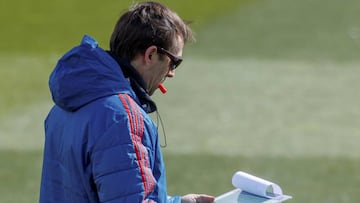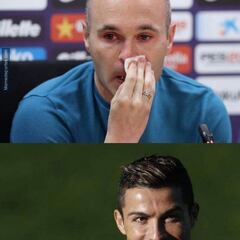Eight important points from Lopetegui's play book
AS analyses the tenets of the coaching style that has brought Julen Lopetegui successes with FC Porto and Spain's underage and senior sides.

1. Dominate possession: “Protagonist” is a word persistently used by Lopetegui. And indeed to do be the protagonist, he believes you need to have the ball and, with it, build the game. Possession matters, but as long as it is used to hurt opponents. That’s why his players have the talent and ability to circulate the ball well, which is very much in line with how the national team has played under him in recent years. This type of player also formed the basis of the FC Porto style during his tenure at the club from 2014 to 2016.
2. Goalkeepers with good feet: Working the ball from the back at the beginning of the game is another feature of Lopetegui’s style of play. The goalkeeper will often opt to play short passes to the defenders rather than hoofing it up field. Therefore a goalkeeper with good feet is fundamental, and for Lopetegui, David De Gea was the best in this department. It remains to be seen whether he will choose Keylor Navas, Kiko Casilla or to bring a new number one at Real Madrid.
3. A modern and methodical tactician: Lopetegui knows that the right strategy can be the differentiating factor in games where there is very little between the sides. Coaching the Spanish underage teams from 2010 to 2014, he employed tactics that gave him results in the form of goals, which he showed again at FC Porto and with the Spanish senior team. It is about working to win free kicks and corners, and varying the approach depending on the opponent’s style of defending. In this sense, he is a modern and methodical tactician that is capable of surprising.
4. Overlapping full backs: Martin Montoya, Dani Carvajal and Alberto Moreno were his chosen full backs for his Under-21 Euro Championship Winning side in 2013 – that is three dynamic, attacking-minded defenders. For Lopetegui, a full back is not worth his salt unless he can be offensive and can contribute to an attack as much as any other player. This type of full back was also employed in his FC Porto team, in the form of Danilo and Alex Sandro. Overlapping and the ability to switch the ball is key, as is, of course, the pace to track back when the ball is lost.
5. A strong defensive midfielder: Fundamental to a Lopetegui side is a midfielder who can not only control the game, but also can contribute to defense and recovery of the ball. In 2013 for the Under-21s it was Real Sociedad’s Asier Illarramendi. At FC Porto it was Casemiro, with whom he will now work again at Real Madrid. As coach of the national team, he saw Saul as a number 6, which is not where he traditionally plays for Diego Simeone at Atlético.
6. A healthy mix of joviality and seriousness in the dressing room: As a player, Lopetegui has been in some great dressing rooms and knows that with the players, you have to know when and how to tighten and loosen the ropes. A jovial atmosphere is necessary, but at times, so too is seriousness and discipline.
Related stories
7. Wingers: Lopetegui likes a certain type of winger who can open the play. In the Under-21s side in 2013, it was Betis’ Cristian Tello, while on the other side was Isco often cutting inside. In his FC Porto team that reached the quarter finals of the Champions League, this was repeated with Quaresma (playing wide) and Brahimi on other flank.
8. The centre forward must be involved: No man is an island, and in a Lopetegui side, that also holds true for the centre forward. Both Rodrigo and Morato in the Under 21 side, and Jackson at FC Porto, were able come to receive the ball, drop back, push out to the wing and combine well with the midfield. He had Iago Aspas and Rodrigo do the same for the national team, and now at Madrid he has Benzema for that job. What remains to be seen is whether he will deploy Ronald as a pure nine, or have him coming in from the sides.

